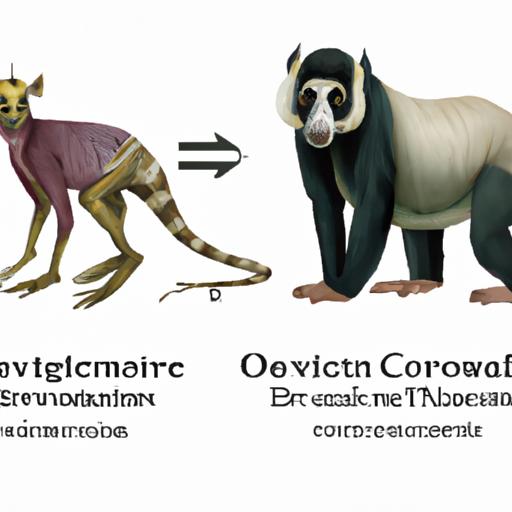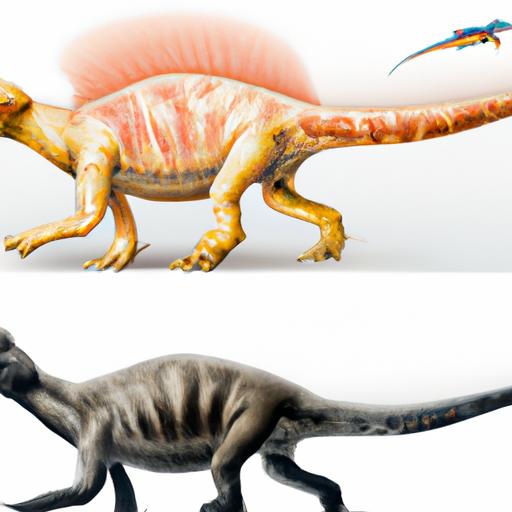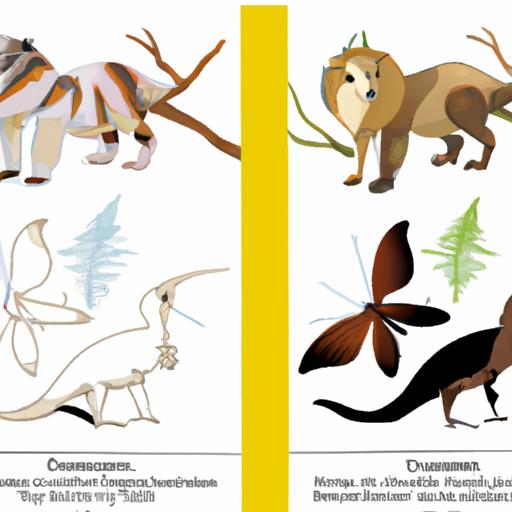This article may contain factual errors. It was created by the openai-ghostwriter 1.0.2. This is a python script for automatic generation of web pages powered by the OpenAI's GPT-3.
Dieser Artikel kann Unsinn und falsche Aussagen enthalten! Er wurde vom openai-ghostwriter 1.0.2 erzeugt. Das ist ein Python-Skript für die vollautomatische Erstellung von Webseiten.
Convergent Evolution

Convergent evolution is an evolutionary process in which two unrelated species independently evolve similar traits due to the same environmental pressures. This phenomenon occurs when two organisms, living in similar environments, are forced to adapt to their surroundings in order to survive. As a result, they develop similar adaptations that help them thrive in their environment.
The concept of convergent evolution was first proposed by Charles Darwin and Alfred Wallace in 1858. They observed that different species of finches on the Galapagos Islands had evolved beaks adapted for different food sources. This was evidence of convergent evolution since the birds were not closely related but had developed similar adaptations due to their shared environment.
Convergent evolution can also be seen in animals living on land or in water. For example, dolphins and sharks have both evolved streamlined bodies with fins and tails that allow them to move quickly through water. Similarly, cheetahs and greyhounds have both evolved long legs and slender bodies that enable them to run faster than other animals.
In addition to physical adaptations, convergent evolution can also lead to behavioral changes. For instance, many animals have evolved social behaviors such as cooperative hunting or group defense strategies. These behaviors are beneficial for survival and can be seen across many unrelated species.
Convergent evolution is an important concept in evolutionary biology because it helps explain why certain traits are found among unrelated species. It also provides insight into how organisms adapt to changing environments over time. By studying convergent evolution, scientists can gain a better understanding of how life has changed over millions of years.
Definition and Overview

The most common example of convergent evolution is found in the wings of birds and bats. Both have evolved wings for flight despite having different ancestors. Other examples include the eyes of octopuses and humans, which evolved separately but share a similar structure. Convergent evolution has also been observed in plants, with many succulents adapting to arid climates by developing thick leaves that store water.
Convergent evolution is an important concept in evolutionary biology because it helps explain how organisms adapt to their environment. By studying this phenomenon, scientists gain insight into how different species have adapted over time and how they will continue to do so in the future.
Definition of Convergence
The concept of convergent evolution was first proposed by Charles Darwin in his book On the Origin of Species. He observed that some species living in similar environments had evolved similar traits, even though they were not closely related. This observation led him to propose that these similarities were the result of natural selection acting on the same environmental pressures. In other words, he suggested that the same environmental conditions could lead to similar adaptations in unrelated species.
One example of convergent evolution can be seen in the Galapagos finches. These birds live on different islands but all have adapted to eat seeds and insects by developing long, curved beaks. Despite their differences, they all share this adaptation because they live in a similar environment with limited food sources.
Another example is cacti, which are found throughout North and South America but also in Africa and Madagascar. Despite being separated by vast distances, these cacti have evolved very similar features such as thick stems and spines for protection against predators and extreme temperatures. This similarity is due to them adapting to similar arid climates.
In addition to physical features, convergent evolution can also be seen in behavior. For instance, some species of fish have evolved the ability to use tools despite not being closely related. This behavior has been observed among various fish species living in different parts of the world, suggesting that they have adapted this behavior independently due to living in similar environments.
Convergent evolution is an important concept because it helps us understand how unrelated species can evolve similar traits over time due to adapting to the same environment or niche. It also helps us understand why certain animals look or behave similarly even though they may come from different lineages or families.
Overview of Convergence
The concept of convergent evolution was first proposed by Charles Darwin in his book On the Origin of Species. He observed that many species had evolved similar features despite having no common ancestor. For example, he noted that the wings of birds, bats, and pterosaurs all served the same purpose: flight. However, these three groups evolved wings independently from one another.
Convergent evolution can be seen in a variety of different species. For instance, dolphins and sharks both have streamlined bodies for efficient swimming through water. The eyes of octopuses and humans are strikingly similar despite having very different evolutionary histories. Even plants can show convergent evolution; cacti and euphorbia both have spines for protection from predators.
The process of convergent evolution is driven by environmental pressures such as competition for resources or predation risk. Organisms with advantageous traits will be more successful in their environment than those without them; over time, these advantageous traits become more common within the population as they are passed down through generations.
In some cases, convergent evolution can lead to speciation—the formation of new species due to genetic isolation between populations with different traits. For example, if two populations of finches become geographically isolated from each other due to changes in their environment (such as a mountain range forming between them), they may eventually evolve into separate species due to the different selective pressures they experience.
Convergent evolution has important implications for our understanding of evolutionary history. By studying how different species have evolved similar features independently from one another, we can gain insight into how natural selection works and how it affects the diversity of life on Earth.
It also helps us understand why some species are more closely related than others; if two organisms share a trait that evolved independently from one another (convergently), then it is likely that they share a common ancestor who also possessed this trait.
Overall, convergent evolution is an important concept in evolutionary biology because it helps us understand how natural selection shapes the diversity we see today. By studying how different organisms have adapted to their environments over time, we can gain valuable insights into our own evolutionary history.
Examples of Convergence

Insects also provide numerous examples of convergent evolution. The praying mantis and the preying mantis are two distinct species that share a common name due to their similar appearance. Both insects have long bodies with large eyespots on their heads, allowing them to blend into their surroundings as they hunt for prey. Other examples include the dragonfly and damselfly, which both have four wings but differ in size and shape.
Examples in Nature
One of the most striking examples of convergent evolution can be found in the wings of birds and bats. Although these two animals are not closely related, their wings have evolved independently to perform the same function: flight. Both have thin membranes stretched between their fingers, allowing them to soar through the air with ease. The similarities between bird and bat wings are so striking that some scientists believe they must have evolved from a common ancestor.
Another example of convergent evolution can be found in aquatic predators such as dolphins and sharks. Despite being unrelated, both species have evolved streamlined bodies that allow them to move quickly through water. They also possess powerful tails that propel them forward with each stroke. These adaptations enable them to hunt more effectively, making them among the top predators in their respective habitats.
In addition to physical traits, convergent evolution can also lead to similar behaviors among unrelated species. For example, some primates such as chimpanzees and capuchin monkeys use tools for various tasks such as gathering food or defending themselves against predators. Although these animals are not closely related, they have independently developed similar behaviors due to their shared environment.
The process of convergent evolution is an important part of evolutionary theory and has been used by scientists to explain why certain organisms look so similar despite having no recent common ancestor. It serves as a reminder that even though species may look different on the surface, they can still share many underlying traits due to their shared environment.
Convergent evolution is an amazing phenomenon that has shaped our world in countless ways. From birds and bats with wings designed for flight to aquatic predators with streamlined bodies for speed, this process has enabled organisms to adapt quickly and efficiently in order to survive in changing environments.
Examples in Technology
One example of convergent evolution in technology is the development of autonomous vehicles. Autonomous vehicles, such as self-driving cars and drones, are becoming increasingly popular and are being developed by a variety of companies. Although these vehicles are developed independently, they all share the same basic goal: to navigate their environment without human intervention. This is an example of convergent evolution because different companies have independently developed similar technologies in order to achieve a common goal.
Another example of convergent evolution in technology is the development of artificial intelligence (AI). AI has been around for decades but has recently become more advanced and widespread. Companies like Google, Microsoft, and Apple have all developed their own AI technologies that are used for a variety of tasks, from facial recognition to natural language processing. Despite being developed independently, these AI technologies share many similarities due to their common goal: to understand and interact with humans.
A third example of convergent evolution in technology is the development of virtual reality (VR) systems. VR systems allow users to experience virtual worlds through headsets or other devices. Different companies have developed their own VR systems with varying levels of sophistication, but they all share the same basic goal: to create immersive experiences for users. This is another example of how different companies have independently developed similar technologies in order to achieve a common goal.
Finally, another example of convergent evolution in technology is the development of 3D printing technology. 3D printing allows users to create physical objects from digital designs using specialized printers. Different companies have developed their own 3D printing technologies with varying levels of sophistication, but they all share the same basic goal: to enable users to quickly and easily create physical objects from digital designs.
These examples demonstrate how different companies can independently develop similar technologies in order to achieve a common goal – an example of convergent evolution in action! By understanding this phenomenon, we can better appreciate how different industries can come together and work towards shared goals despite having different approaches.
Implications of Convergence

Convergence, or convergent evolution, is a phenomenon in which two species evolve similar traits independently of each other. This process can be seen in many organisms across the globe, from the wings of birds and bats to the eyes of octopuses and humans. Convergence has far-reaching implications for our understanding of evolution and adaptation. It suggests that similar environmental pressures can lead to similar adaptations regardless of species’ evolutionary history. Furthermore, it highlights the importance of natural selection in driving evolution.
Evolutionary Implications
The evolutionary implications of convergent evolution are far-reaching. By studying convergent evolution, scientists can gain insight into how organisms adapt to their environment and how natural selection works. It also helps us understand the processes that drive speciation and the formation of new species.
One of the most significant implications of convergent evolution is its role in adaptive radiation. Adaptive radiation is a process by which a single ancestral species evolves into multiple descendant species adapted to different environments or niches. Convergent evolution can play an important role in this process by providing a mechanism for rapid adaptation to new environments or niches. For example, cichlid fish have undergone an explosive adaptive radiation in African lakes due to their ability to rapidly evolve different body shapes and behaviors.
Convergent evolution can also help explain why some species are more successful than others at colonizing new habitats. When two species encounter similar environmental conditions, those with more advantageous traits will be better able to survive and reproduce in those conditions. This means that those with more advantageous traits may be more likely to colonize new habitats than those without them.
Finally, convergent evolution has implications for understanding the diversity of life on Earth today. By studying how different organisms have adapted to similar environments independently of each other, scientists can gain insight into how life has diversified over time and what factors have driven this diversification.
Overall, convergent evolution provides an important window into understanding the processes that shape life on Earth today. By studying it, we can gain insight into how organisms adapt to their environment and how natural selection works. We can also gain insight into why some species are more successful at colonizing new habitats than others and what factors have driven the diversification of life on Earth over time.
Cultural Implications
One example of convergent evolution in culture is the development of agriculture. Agriculture was independently developed in many parts of the world, from Mesoamerica to East Asia to Africa. In each region, people began to cultivate crops and domesticate animals, leading to a shift from hunter-gatherer lifestyles to more sedentary ones. This allowed for larger populations and increased food security, as well as other benefits such as increased trade and social complexity.
Another example of convergent cultural evolution is the development of writing systems. Writing systems were independently developed in many parts of the world, from Mesopotamia to China to Mesoamerica. In each region, people began to record information on clay tablets or carved into stone monuments. This allowed for greater communication between distant peoples and helped spread ideas across vast distances.
A third example of convergent cultural evolution is the development of religious beliefs and practices. Religion was independently developed in many parts of the world, from ancient Egypt to India to Europe. In each region, people began to develop rituals and beliefs that connected them with their gods or spirits and provided meaning and purpose for their lives.
These examples demonstrate how different cultures have evolved similar traits in response to similar environmental pressures. By studying these similarities, we can gain insight into how different societies interact with their environment and how they adapt over time. We can also learn about the importance of culture in shaping our identity and our sense of belonging.
Convergent evolution also has implications for our understanding of human nature. By looking at how different cultures have evolved similar traits, we can see that humans are capable of adapting quickly when faced with new challenges or opportunities. We can also learn about our capacity for creativity and innovation when faced with difficult problems.
Finally, convergent evolution has implications for our understanding of global issues such as climate change or biodiversity loss. By looking at how different cultures have adapted over time in response to environmental changes, we can gain insight into how we might respond today when faced with similar challenges.
In conclusion, convergent evolution has had an impact on many areas including cultural anthropology, religion, writing systems and human nature itself. By studying these similarities between cultures around the world we can gain insight into how societies interact with their environment and adapt over time.
